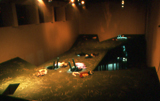Bruce Barber Interviews Rita
|
BB: You are now identified (through the 7a*11d festival in Toronto) as an eminence grise performance artist in Canada. During your 30-year career, which work or works would you identify as your most significant and for what reasons?
RM: Defunct was my first major installation. It took place at the Illingworth Kerr Gallery in Calgary in 1981. It was a work for which I brought together audio, performance and installation. For this piece I received tremendous support from my friends and the arts community in Calgary, and this gave me the confidence to pursue my installation work. In Bocca al Lupo/In the Mouth of the Wolf (1991) was overall the most significant for me because of the scale and complexity of the work and the amazing performers and musicians I was able to collaborate with. It was a major shift in my engagement with the practice of performance. Take It to the Teeth (1993) was the most difficult work to perform but it clarified for me the importance of performance to my practice and it gave me the resolve to focus my attention there. Shudder (1998) was a complex work for me theoretically and in it I felt that I found my voice in the text and writing of the performance. It also represented an important shift in my use of electronics. I began to focus on developing ‘performing objects’ that could enact gestures and activities and perform with me. Tower of Silence was my favourite piece in terms of its visual impact and the integration of the audio and musical components. Outskirts (2003) was important to me because of the connection between the performance and the installation and what I felt was a good balance between the humour and my social and political concerns. It was the performance I enjoyed the most to date. I was able to remove much of the drama from the performance and I felt much more interested in this approach. Long Haul (1996) was the most engaging public performance for me and the relationship between the performance and the installation had integrity of concept that was very important to me. BB: In my essay on “Three Modes of Performance in Canada in the Nineties” I identified your work and that of other feminist performance artists as “fem/active.” Work in this political category focuses on gender issues, sexual orientation, work and gender equity, reproductive technologies, race, ethnicity, class, violence against women, child abuse, female power and ecology issues. Are you comfortable being identified with this ‘category’ and which if any of these issues would you say you are most engaged with in your work? RM: Yes. I am very happy to be identified in this category. Violence against women was a major focus of my work from 1983 to 1992. I feel that in all of my work I speak from a feminist perspective, sometimes more directly than others. |
  |
